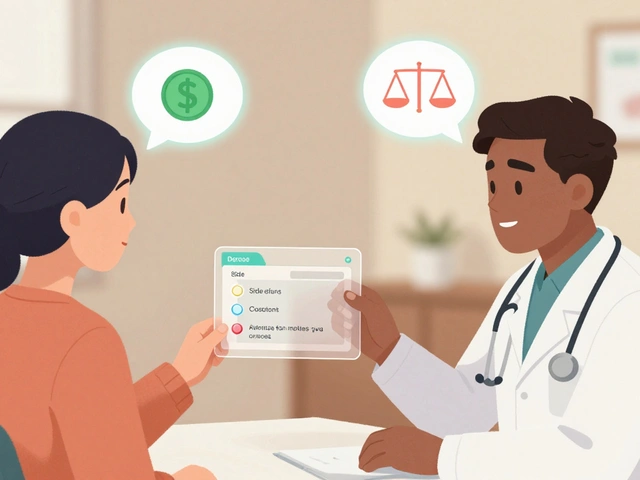Warfarin vs. DOACs: What You Need to Know About Anticoagulant Safety

When you’re on a blood thinner, safety isn’t just a concern-it’s your daily reality. Two main types of anticoagulants dominate modern treatment: warfarin and direct oral anticoagulants (DOACs). Both prevent dangerous clots in conditions like atrial fibrillation and deep vein thrombosis, but their risks, benefits, and daily impacts are worlds apart. If you’ve been prescribed one-or are deciding between them-you need to know exactly how they compare in real-world safety.
Why Warfarin Has Been the Standard for Decades
Warfarin has been around since 1954. For over 60 years, it was the only reliable option to stop clots from forming in the heart, lungs, or legs. It works by blocking vitamin K, which your body needs to make clotting proteins. But that simplicity comes with a heavy cost: constant monitoring. Every patient on warfarin needs regular blood tests-INR checks-to make sure their blood isn’t too thin or too thick. The goal is to keep the INR between 2.0 and 3.0. Go below that, and clots can form. Go above, and you risk bleeding inside your brain, stomach, or other organs. The problem? Warfarin interacts with over 300 medications and dozens of foods. Eating a big bowl of spinach, kale, or broccoli one day and not the next can swing your INR wildly. Antibiotics, painkillers, even herbal supplements like St. John’s wort can throw your dose off. That’s why many patients end up in the ER after a missed test or a sudden dietary change.How DOACs Changed the Game
Starting in 2010, DOACs like apixaban, rivaroxaban, dabigatran, and edoxaban began replacing warfarin. These drugs don’t need INR tests. They don’t care what you eat. They work directly on specific clotting factors-either factor Xa or thrombin-and their effects are much more predictable. That predictability is why DOACs are now the first choice for most people with atrial fibrillation or deep vein thrombosis. According to the American Heart Association’s 2023 guidelines, DOACs reduce stroke risk by 20% and intracranial bleeding by 50% compared to warfarin. In a 2023 JAMA Network Open study, patients on DOACs had 34% fewer recurrent clots over time than those on warfarin. And the numbers don’t lie. As of mid-2023, DOACs made up 78% of all anticoagulant prescriptions in the U.S. Apixaban alone (sold as Eliquis) was prescribed more than any other blood thinner in the country.The Safety Trade-Offs: DOACs Aren’t Perfect
Just because DOACs are safer overall doesn’t mean they’re risk-free. They still cause bleeding-sometimes serious, sometimes fatal. But the type of bleeding differs. Warfarin is more likely to cause brain bleeds. DOACs are more likely to cause stomach or GI bleeding, especially in older adults. Renal function matters a lot. Dabigatran is cleared mostly by the kidneys-80% of it. If your kidneys are weak (eGFR below 30), it can build up and increase bleeding risk. Apixaban, on the other hand, is cleared mostly by the liver, making it safer for people with kidney disease. In fact, studies show apixaban has the lowest bleeding rate among DOACs. And here’s a key point: DOACs have no universal antidote. You can reverse warfarin with vitamin K or fresh plasma. For DOACs, reversal agents exist-but only for specific drugs. Idarucizumab (Praxbind) reverses dabigatran. Andexanet alfa (Andexxa) reverses apixaban and rivaroxaban. Edoxaban? No approved reversal agent yet. That’s critical if you’re in an accident or need emergency surgery.
Who Still Needs Warfarin?
Despite the shift to DOACs, warfarin hasn’t disappeared. It’s still the only option for people with mechanical heart valves. DOACs can cause clots on these valves-sometimes with deadly results. The 2023 American College of Chest Physicians guidelines are clear: DOACs are contraindicated here. Warfarin is also preferred for patients with severe kidney failure (eGFR below 15) or those on dialysis. While some studies show DOACs might be safer even in advanced kidney disease, the data isn’t strong enough yet for broad recommendations. Most doctors still stick with warfarin in these cases. Patients with mitral stenosis-especially from rheumatic heart disease-also need warfarin. DOACs haven’t been proven safe here.Cost and Adherence: The Hidden Factors
Warfarin costs about $4 for a 30-day supply. Apixaban? Around $587. Rivaroxaban? $523. That’s not a typo. Even with insurance, copays for DOACs can be hundreds of dollars a month. For many patients, especially those on fixed incomes, that’s a dealbreaker. But cost isn’t just about the pill price. Warfarin users spend hundreds more a year on lab tests, doctor visits, and emergency trips for INR spikes. A 2023 Circulation study found DOACs become more cost-effective than warfarin when patients miss more than 35% of their INR checks-which happens often. Adherence is another big difference. A 2023 American Journal of Managed Care study found DOAC users were 32% more likely to take their medication consistently. For people under 45, that gap jumped to 41%. Why? No blood tests. No food restrictions. No daily stress over spinach.What You Should Ask Your Doctor
If you’re starting or switching anticoagulants, here are five questions to ask:- Do I have a mechanical heart valve or severe mitral stenosis? If yes, warfarin is likely your only option.
- What’s my kidney function? If my eGFR is below 30, which DOAC is safest-or should I stay on warfarin?
- Am I on any other medications that could interact with DOACs? Some antibiotics, antifungals, and seizure meds can raise DOAC levels dangerously.
- What’s my risk of bleeding? If I’ve had a GI bleed before, apixaban might be better than rivaroxaban.
- Can I afford this long-term? If cost is a barrier, can we explore patient assistance programs?





Gus Fosarolli
November 28, 2025 AT 00:41DOACs are great until you need emergency surgery and your docs are like ‘uhhhhh, which one was it again?’ and you’re just sitting there thinking ‘I ate kale yesterday so I’m definitely fine.’
Also, why is apixaban the only one that doesn’t make you feel like a lab rat? Someone please tell me the secret sauce.
Evelyn Shaller-Auslander
November 29, 2025 AT 21:34i just started on eliquis and honestly? no more finger pricks = life changed. also, i ate spinach last night and didn’t die. miracle.
shelly roche
December 1, 2025 AT 20:58As someone who’s been on warfarin for 8 years after a pulmonary embolism, I get the hype around DOACs-but let’s not pretend they’re magic.
My mom had a GI bleed on rivaroxaban and we had zero reversal options. Warfarin? We had vitamin K, plasma, a plan. That matters when you’re 72 and living alone.
Also, if you’re in a country where $600/month meds aren’t covered, DOACs aren’t a ‘better choice’-they’re a luxury. And that’s not fair.
Nirmal Jaysval
December 2, 2025 AT 15:23doacs are for ppl who dont wanna think. warfarin is for ppl who wanna live. if ur kidney is trash, u dont wanna be on dabigatran. trust me, i saw it happen.
also, why is everyone acting like warfarin is from the dark ages? it worked for my grandpa and he lived to 92.
Emily Rose
December 4, 2025 AT 00:03Can we just talk about how ridiculous it is that we’re still debating this? DOACs reduce intracranial bleeding by HALF. That’s not a ‘trade-off,’ that’s a win.
And if you’re on warfarin because you can’t afford DOACs, that’s a healthcare failure-not a personal choice. We need better access, not more guilt-tripping.
Also, if your doctor didn’t ask about your kidney function or meds, find a new one. Period.
Benedict Dy
December 4, 2025 AT 20:25The data presented here is statistically sound but dangerously oversimplified. The JAMA study cited has a 2.3% attrition rate and lacks real-world adherence correction. Also, the cost analysis ignores pharmacy benefit manager rebates, which skew DOAC pricing.
Furthermore, the ‘no universal antidote’ point is overstated-most ERs now stock Andexxa and Praxbind. The real issue is institutional preparedness, not drug design.
And let’s not forget: warfarin’s long half-life allows for easier bridging in perioperative settings. DOACs require precise timing, which is rarely achieved outside clinical trials.
Emily Nesbit
December 6, 2025 AT 13:04Apixaban has the lowest bleeding rate among DOACs, yes-but only in trials with patients who took their meds exactly as prescribed. In real life? Adherence drops to 68%. That’s not ‘safer.’ That’s ‘riskier if you forget.’
Also, ‘no food restrictions’ is misleading. Grapefruit still interacts with apixaban. So does St. John’s wort. So does a lot of OTC stuff. People think ‘no INR’ means ‘no rules.’ It doesn’t.
John Power
December 8, 2025 AT 12:58I’ve been on warfarin since 2016 after a stroke. I get the DOAC hype. But I also know my body. My INR is stable. I know what spinach does to me. I’ve got a routine.
And honestly? I’d rather have a weekly blood test than pray nothing hits my meds or kidneys. If DOACs work for you? Cool. Don’t act like I’m outdated for sticking with what keeps me alive.
Richard Elias
December 8, 2025 AT 15:07Anyone who says DOACs are ‘easier’ hasn’t tried to get insurance to cover them. My copay was $320 last month. Warfarin? $12. I’m not ‘lazy’-I’m broke.
Also, why is everyone acting like warfarin users are dumb? We’ve been doing this for decades. We’re not idiots. We’re just not rich.
Jerrod Davis
December 9, 2025 AT 06:34The assertion that DOACs are ‘more cost-effective’ when INR adherence falls below 35% is based on a flawed model that assumes linear cost progression for laboratory services and ignores the marginal utility of each INR test.
Furthermore, the cited Circulation study did not adjust for regional healthcare pricing disparities, rendering its generalizability questionable.
It is therefore premature to conclude that DOACs represent a net economic benefit across all socioeconomic strata without further stratified analysis.